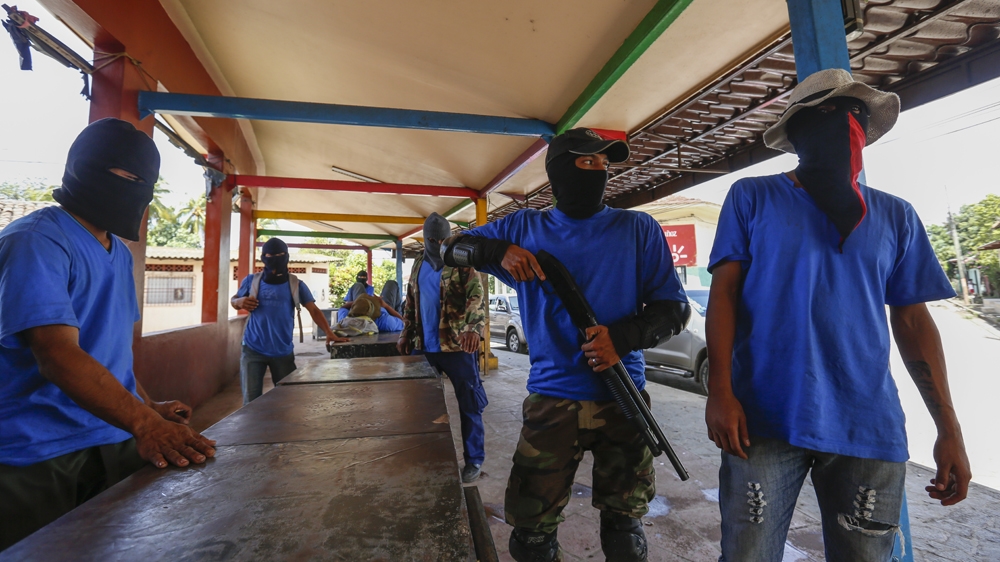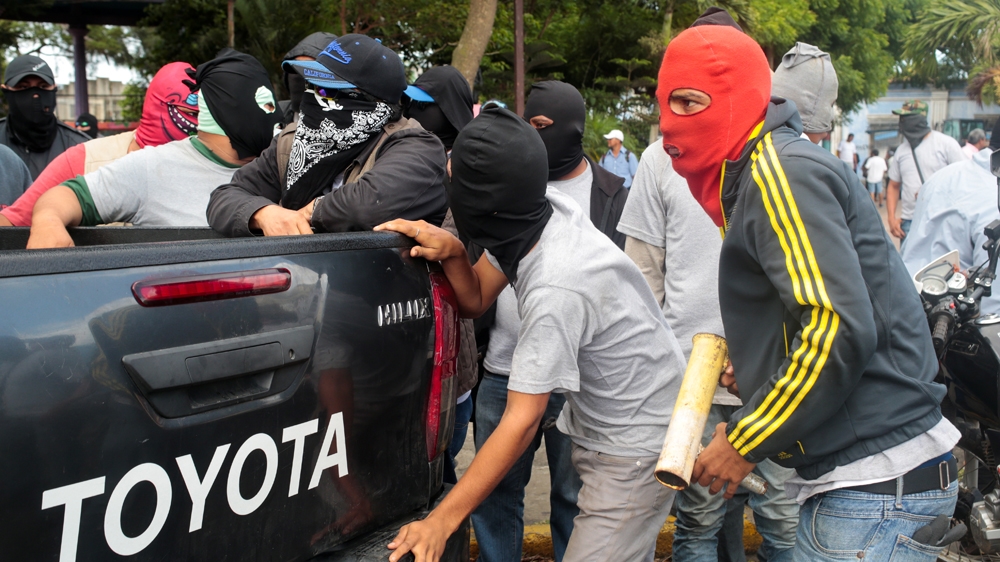
On July 17, footage emerged online of masked men hoisting a red-and-black flag emblazoned with the letters FSLN in what they said was Monimbo, a neighbourhood in the south Nicaraguan city of Masaya.
“Long live the Sandinista Front!” the men shouted, some of them pointing rifles into the sky.
“Sandino lives, the fight continues!” they chanted, clenching their fists in the air.
Just before, pro-government gunmen and police took control of the neighbourhood, which had been an opposition stronghold, after several hours of clashes with demonstrators who had set up barricades in the streets.
The capture of the neighbourhood by forces loyal to President Daniel Ortega was described by Reuters news agency as a symbolic blow to those trying to oust the embattled leader.
‘The mobs’
Scenes of masked gunmen travelling in convoys of Toyota Hiluxes became prevalent in Nicaragua after anti-government protests over social security reforms broke out in mid-April.
These groups have been referred to in Spanish as “las turbas” (the mobs) and “parapolicias” (parapolice) as well as paramilitary groups. They have been accused of carrying out much of the repression of protesters on behalf of President Ortega and his Sandinista National Liberation Front (FSLN) party. Ortega has denied any involvement.
Demonstrations against planned pension reforms quickly spiraled into calls for the resignation of Ortega and his wife, Vice President Rosario Murillo, after reports emerged of a deadly crackdown against protesters.
Since April, 317 people have been killed in the the unrest according to the Inter-American Commission for Human Rights (IACHR), which is part of the Organisation of American States (OAS). The Nicaraguan Association for Human Rights (ANPDH) put the death toll closer to 450.
The government has said that between April 19 and July 25, 197 people have died as a result of the protests, including 22 police officers.
The United Nations Human Rights Commissioner in June said killings happened “almost entirely at the hands of police forces and by armed pro-government groups”.
During so-called “clean-up operations” in July, police and masked pro-government gunmen were accused of carrying out raids of pro-opposition neighbourhoods in and around the city of Masaya – including the one in Monimbo.
 |
| Pro-government gunmen occupy Monimbo on July 18 [Alfredo Zuniga/The Associated Press] |
Around the same time, pro-government groups trapped around 200 students inside a church by gunfire amid an operation to clear student protesters from the campus of the National Autonomous University of Nicaragua (UNAN), where they had barricaded themselves in. They were later freed, but at least two students were killed.
Ortega himself has denied responsibility for the armed groups, but Elvira Cuadra, an associate and former director at the Nicaragua-based Institute for Strategic Studies and Public Policy (IEEPP) told Al Jazeera it is “evident” there is a “close and direct” relationship between Ortega’s government and the pro-government armed groups.
She said the armed groups are alerted by the government, have been equipped with vehicles by “police and other institutions” and work together and in plain sight of police.
Their principal objectives are to “put fear into the population, kidnapping youth who then appear in police jails [and] carrying out armed actions with high-calibre weapons of war”, she said.
“They have become a big danger and a risk for the rest of the population in Managua and the country’s other major cities.”
‘Normal resident’
Government supporters have denied there is a link between the gunmen and Ortega’s government.
After the capture of Monimbo, one man in a black ski mask and blue t-shirt told AP news agency he was “a normal resident”, denying he and others were government-backed paramilitaries.
In a rare televised interview with Fox News broadcast in July, Ortega denied responsibility for the actions of the armed groups and said they instead work for political organisations that oppose his government.
There has been a “campaign of lies, terrible lies, to try to hurt the image of Nicaragua and of its government,” Ortega told the US broadcaster.
He denied any peaceful protesters had been attacked and said, without providing evidence, the armed groups had been financed with money from drug trafficking and in some cases had tried to attain funding from the US.
In a later interview with Euronews, Ortega said the armed groups were “volunteer police”.
 |
| Government supporters stand in front of a church in Diriamba [Oswaldo Rivas/Reuters] |
FSLN symbols
Independent security consultant Roberto Orozco said he believed the FSLN flags brandished by masked men in Nicaraguan localities such as Monimbo tell a different story.
“The use of FSLN symbology by the parapolice groups show the links that the FSLN and Daniel Ortega have with them,” he told Al Jazeera.
The existence of armed groups outside of Nicaragua’s regular army is nothing new, Orozco explained, and is partially the result of the FSLN’s history as a rebel force.
Ortega was among the Sandinista leftists who in 1979 overthrew Nicaraguan dictator Anastasio Somoza. Since then, the FSLN, which went on to rule Nicaragua until 1990 and again from 2007 onwards, has always maintained an armed element, Orozco said.
“The FSLN fighters who have stuck with Ortega are the smallest part [of the pro-government armed groups] and make up the most fundamentalist, orthodox and fanatic part,” Orozco said.
Since 2007, after Ortega won elections again, Nicaragua has seen the strengthening and creation of pro-government groups with other types of members, including ex-military staff and, according to Orozco, criminals and gang members recruited by political secretaries operating in the barrios (neighbourhoods).
Members of the Juventud Sandinista, the FSLN’s youth wing, which was founded in 1979, and plain-clothes police officers have reportedly also carried out attacks on anti-government protesters.
While these armed groups have long been in the possession of arms, Orozco said, they have recently upgraded from small weapons such as pistols and shotguns to “weapons of war”.
Since the start of the unrest, there have been reports in Nicaraguan media of the armed groups using weapons including AK-47s, RPG-7 rocket launchers and Dragunov sniper rifles.
Orozco said the loyalty of these armed groups has less to do with left-wing Sandinista ideology and more to do with “direct or indirect economic benefits” through association with the FSLN.
Some members of pro-government groups are paid, Orozco alleges, while for others their relationship with FSLN might award them a degree of impunity in running illegal businesses. “There are some for example who can traffick drugs and aren’t captured,” Orozco claimed.
An unnamed source reportedly connected to Nicaragua’s police told opposition website Confidencial that the “vigilante groups” are made up of Managua City Hall employees, civilian-dressed police officers, former officers, veteran guerrilla fighters and gang members from Managua and other cities. The source said they are paid 300 to 500 cordobas ($9 to $16) and are given fuel vouchers for their motorbikes or, if they travel in pick-up trucks, full tanks.
‘High degree of collaboration’
The IACHR, which has had a monitoring mechanism in place in Nicaragua since late June, has not yet investigated the membership of the pro-armed groups.
It did not comment on the identity of the masked individuals carrying out the attacks, but the organisation has spoken out about cooperation between the national police force and pro-government armed groups.
“At the beginning of the protests it was more acquiescence [on the part of the police] … but the last two weeks we have registered a high degree of collaboration between the national police and the [third armed] groups and actually they haven’t even been hiding it,” IACHR Nicaragua Commissioner Antonia Urrejola told Al Jazeera.
In a statement, the IACHR said that during the “clean-up” operations in and near Masaya, police officers and “masked parapolice forces” would “coordinate their actions to perpetrate violence, repress, harass and persecute civilians as well as to remove tranques [barricades]”.
Urrejola said there were also testimonies of “third party groups that are detaining and mistreating people and then giving them to the police force who take them to jails”.
Nicaragua’s National Police did not respond to Al Jazeera’s multiple requests for comment.
While many protesters have remained peaceful, Urrejola added that IACHR also has information on “very small” armed groups that have been using violence against government supporters.
“The increasing social violence in the country is something that really worries us. We have seen reactions that go beyond the scope of peaceful protests,” she said.
Amnesty International echoed the findings by the IACHR on cooperation with police.
“We have documented that pro-government armed groups work in collaboration and with the support or acquiescence of the police,” Central America researcher Astrid Valencia told Al Jazeera.
“That’s what makes the Nicaraguan state responsible for the acts of these groups.”
‘One more invention’
Nicaragua’s regular army, meanwhile, has distanced itself from Ortega by saying it would not crack down on protesters.
“We don’t have a reason to repress,” protesters, Colonel Manuel Guevara told AFP news agency in May.
“We think dialogue is the solution,” the military spokesperson said.
Since the operations in Masaya and at the UNAN campus have ended, Nicaragua has entered a period of relative calm.
In late July, IACHR Executive Secretary Paulo Abrao said Nicaragua had entered a third phase of the crackdown. He characterised it as “bureaucratic repression” and “uses the criminal and justice system to detain people”.
On Friday, the Associated Press reported that more than 2,000 people have been arrested since protests broke out. Students who had been detained told the news agency police had been joined in the interrogation by paramilitaries.












